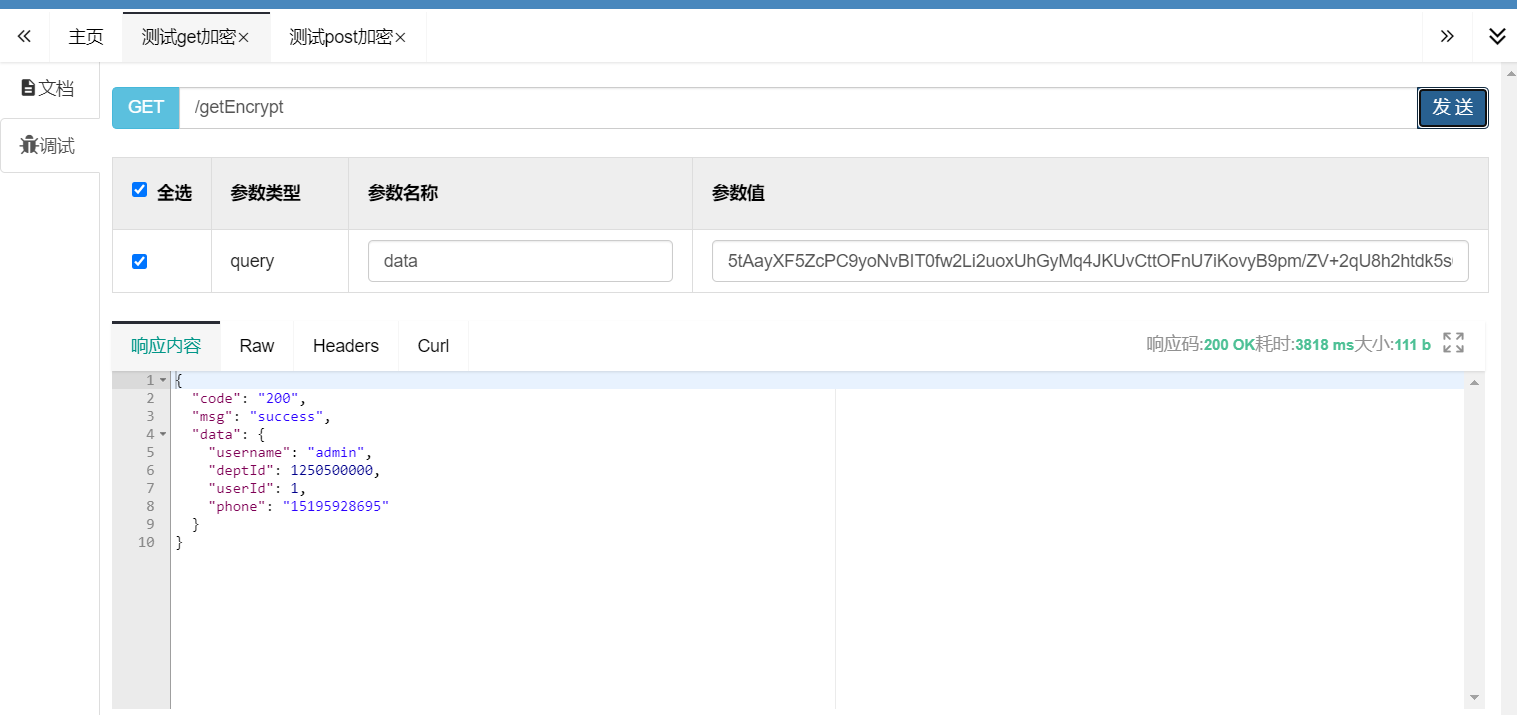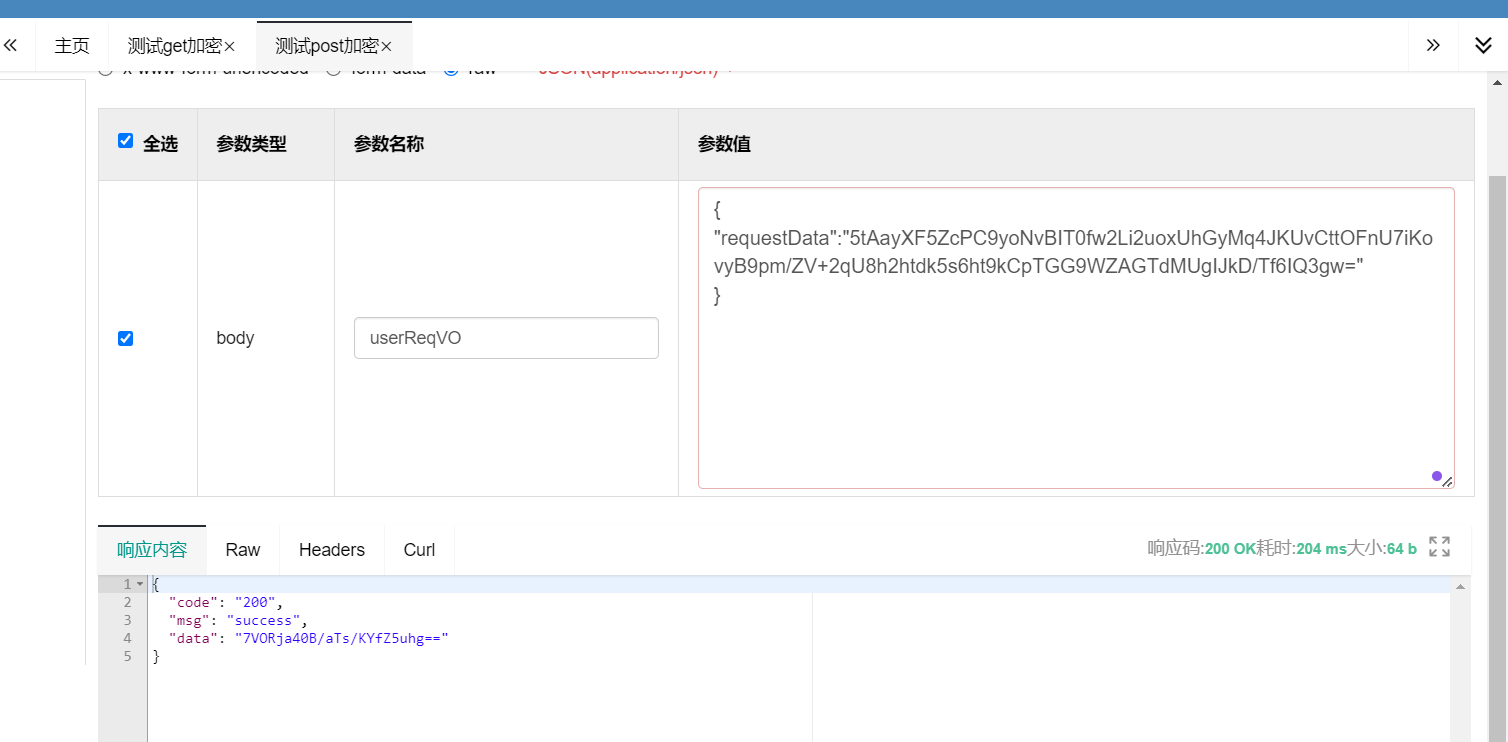SpringBoot请求参数加密、响应参数解密_springboot 拦截器对post请求进行加解密处理-程序员宅基地
技术标签: spring boot 解决方案 java 后端
SpringBoot请求参数加密、响应参数解密
1.说明
在项目开发工程中,有的项目可能对参数安全要求比较高,在整个http数据传输的过程中都需要对请求参数、响应参数进行加密,也就是说整个请求响应的过程都是加密处理的,不在浏览器上暴露请求参数、响应参数的真实数据。
补充:也可以用于单点登录,在请求参数中添加时间戳,后台解析请求参数对时间戳进行校验,比如当前时间和请求参数中的时间戳相差多少秒、分钟才能进行放行,返回token。这样做的好处在于请求端每次加密之后的密文都是变化的,也能够避免携带相同的报文可以重复的登录。
2.准备工作
1.引入依赖, 创建SpringBoot工程
<dependencies>
<dependency>
<groupId>org.springframework.boot</groupId>
<artifactId>spring-boot-starter-web</artifactId>
</dependency>
<dependency>
<groupId>org.projectlombok</groupId>
<artifactId>lombok</artifactId>
</dependency>
<dependency>
<groupId>cn.hutool</groupId>
<artifactId>hutool-all</artifactId>
</dependency>
<dependency>
<groupId>commons-io</groupId>
<artifactId>commons-io</artifactId>
<version>2.11.0</version>
</dependency>
<dependency>
<groupId>junit</groupId>
<artifactId>junit</artifactId>
</dependency>
<dependency>
<groupId>commons-codec</groupId>
<artifactId>commons-codec</artifactId>
</dependency>
<dependency>
<groupId>org.springframework.boot</groupId>
<artifactId>spring-boot-starter-aop</artifactId>
</dependency>
<!--swagger-->
<dependency>
<groupId>io.springfox</groupId>
<artifactId>springfox-swagger2</artifactId>
<version>3.0.0</version>
</dependency>
<dependency>
<groupId>io.springfox</groupId>
<artifactId>springfox-swagger-ui</artifactId>
<version>3.0.0</version>
</dependency>
<dependency>
<groupId>io.swagger</groupId>
<artifactId>swagger-annotations</artifactId>
<version>1.5.22</version>
</dependency>
<dependency>
<groupId>com.github.xiaoymin</groupId>
<artifactId>swagger-bootstrap-ui</artifactId>
<version>1.8.7</version>
</dependency>
<dependency>
<groupId>org.apache.commons</groupId>
<artifactId>commons-lang3</artifactId>
</dependency>
</dependencies>
3.代码实现
1.定义两个注解
/**
* @description: : 请求参数解密
*/
@Target(ElementType.METHOD)
@Retention(RetentionPolicy.RUNTIME)
@Documented
public @interface DecryptionAnnotation {
}
/**
* @description: 响应参数加密
*/
@Target(ElementType.METHOD)
@Retention(RetentionPolicy.RUNTIME)
@Documented
public @interface EncryptionAnnotation {
}
2.加密解密实现核心代码
DecryptRequestBodyAdvice:请求参数解密,针对post请求
package com.llp.crypto.advice;
import cn.hutool.json.JSONUtil;
import com.llp.crypto.annotation.DecryptionAnnotation;
import com.llp.crypto.utils.AESUtil;
import lombok.SneakyThrows;
import lombok.extern.slf4j.Slf4j;
import org.apache.commons.io.IOUtils;
import org.springframework.core.MethodParameter;
import org.springframework.http.HttpHeaders;
import org.springframework.http.HttpInputMessage;
import org.springframework.http.converter.HttpMessageConverter;
import org.springframework.web.bind.annotation.ControllerAdvice;
import org.springframework.web.bind.annotation.PostMapping;
import org.springframework.web.servlet.mvc.method.annotation.RequestBodyAdvice;
import java.io.IOException;
import java.io.InputStream;
import java.lang.reflect.Type;
/**
* @description: 请求参数解密,针对post请求
*/
@Slf4j
@ControllerAdvice
public class DecryptRequestBodyAdvice implements RequestBodyAdvice {
/**
* 方法上有DecryptionAnnotation注解的,进入此拦截器
*
* @param methodParameter 方法参数对象
* @param targetType 参数的类型
* @param converterType 消息转换器
* @return true,进入,false,跳过
*/
@Override
public boolean supports(MethodParameter methodParameter, Type targetType, Class<? extends HttpMessageConverter<?>> converterType) {
return methodParameter.hasMethodAnnotation(DecryptionAnnotation.class);
}
@Override
public HttpInputMessage beforeBodyRead(HttpInputMessage inputMessage, MethodParameter parameter, Type targetType, Class<? extends HttpMessageConverter<?>> converterType) throws IOException {
try {
return new MyHttpInputMessage(inputMessage, parameter);
} catch (Exception e) {
throw new RuntimeException(e);
}
}
/**
* 转换之后,执行此方法,解密,赋值
*
* @param body spring解析完的参数
* @param inputMessage 输入参数
* @param parameter 参数对象
* @param targetType 参数类型
* @param converterType 消息转换类型
* @return 真实的参数
*/
@SneakyThrows
@Override
public Object afterBodyRead(Object body, HttpInputMessage inputMessage, MethodParameter parameter, Type targetType, Class<? extends HttpMessageConverter<?>> converterType) {
log.info("解密后的请求报文:{}", body);
return body;
}
/**
* 如果body为空,转为空对象
*
* @param body spring解析完的参数
* @param inputMessage 输入参数
* @param parameter 参数对象
* @param targetType 参数类型
* @param converterType 消息转换类型
* @return 真实的参数
*/
@Override
public Object handleEmptyBody(Object body, HttpInputMessage inputMessage, MethodParameter parameter, Type targetType, Class<? extends HttpMessageConverter<?>> converterType) {
return body;
}
class MyHttpInputMessage implements HttpInputMessage {
private HttpHeaders headers;
private InputStream body;
private MethodParameter parameter;
public MyHttpInputMessage(HttpInputMessage inputMessage, MethodParameter parameter) throws Exception {
this.headers = inputMessage.getHeaders();
//只对post请求进行加密
if (parameter.hasMethodAnnotation(PostMapping.class)) {
/*
*请求报文示例:
* {
* "requestData":"JF7kvl9Wd/vgdmAS8JijsQ=="
* }
*/
String decrypt = AESUtil.decrypt(easpData(IOUtils.toString(inputMessage.getBody(), "UTF-8")));
log.info("解密后的请求参数:{}", decrypt);
this.body = IOUtils.toInputStream(decrypt, "UTF-8");
} else {
this.body = inputMessage.getBody();
}
}
@Override
public InputStream getBody() throws IOException {
return body;
}
@Override
public HttpHeaders getHeaders() {
return headers;
}
}
public String easpData(String requestData) {
if (requestData != null && !requestData.equals("")) {
String start = "requestData";
if (requestData.contains(start)) {
return JSONUtil.parseObj(requestData).getStr(start);
} else {
throw new RuntimeException("参数【requestData】缺失异常!");
}
}
return "";
}
}
GetDeleteDecryptAspect:针对get、delete请求参数进行解密
@Aspect
//值越小优先级越高
@Order(-1)
@Component
@Slf4j
public class GetDeleteDecryptAspect {
/**
* 对get、delete方法进行解密
* @param point
* @return
* @throws Throwable
*/
@Around("@annotation(com.llp.crypto.annotation.DecryptionAnnotation) && " + "(@annotation(org.springframework.web.bind.annotation.GetMapping) || @annotation(org.springframework.web.bind.annotation.DeleteMapping))")
public Object aroundMethod(ProceedingJoinPoint point) throws Throwable {
MethodSignature signature = (MethodSignature) point.getSignature();
Method method = signature.getMethod();
// 获取到请求的参数列表
Object[] args = point.getArgs();
// 判断方法请求参数是否需要解密
if (method.isAnnotationPresent(DecryptionAnnotation.class)) {
try {
this.decrypt(args, point);
log.info("返回解密结果=" + args);
} catch (Exception e) {
e.printStackTrace();
log.error("对方法method :【" + method.getName() + "】入参数据进行解密出现异常:" + e.getMessage());
}
}
// 执行将解密的结果交给控制器进行处理,并返回处理结果
return point.proceed(args);
}
/**
* 前端对请求参数进行加密,最终将这个加密的字符串已 localhost:48080?data=xxx这样的方式进行传递
* 后端后去到 data的数据进行解密最终得到解密后的数据
* @param args
* @param point
* @throws Exception
*/
// 解密方法
@SuppressWarnings("unchecked")
public void decrypt(Object[] args, ProceedingJoinPoint point) throws Exception {
ServletRequestAttributes sc = (ServletRequestAttributes) RequestContextHolder.getRequestAttributes();
HttpServletRequest request = sc.getRequest();
String data = request.getParameter("data");
log.info("data: " + data);
// 将密文解密为JSON字符串
Class<?> aClass = args[0].getClass();
log.info("数据类型:{}",aClass.getClass());
if (StringUtils.isNotEmpty(data)) {
// 将JSON字符串转换为Map集合,并替换原本的参数
args[0] = JSONUtil.toBean(AESUtil.decrypt(data), args[0].getClass());
}
}
}
EncryptResponseBodyAdvice:响应参数解密,针对统一返回结果类的装配
/**
* @description: 响应加密
*/
@Slf4j
@ControllerAdvice
public class EncryptResponseBodyAdvice implements ResponseBodyAdvice {
@Override
public boolean supports(MethodParameter methodParameter, Class aClass) {
return methodParameter.hasMethodAnnotation(EncryptionAnnotation.class);
}
@Override
public Object beforeBodyWrite(Object body, MethodParameter methodParameter, MediaType mediaType, Class aClass, ServerHttpRequest serverHttpRequest, ServerHttpResponse serverHttpResponse) {
log.info("对方法method :【" + methodParameter.getMethod().getName() + "】返回数据进行加密");
// 只针对回参类型为CommonResult的对象,进行加密
if (body instanceof CommonResult) {
CommonResult commonResult = (CommonResult) body;
Object data = commonResult.getData();
if (Objects.nonNull(data)) {
// 将响应结果转换为json格式
String result = JSONUtil.toJsonStr(data);
log.info("返回结果:{}", result);
try {
String encrypt = AESUtil.encrypt(result);
commonResult.setData(encrypt);
log.info("返回结果加密=" + commonResult);
} catch (Exception e) {
log.error("对方法method :【" + methodParameter.getMethod().getName() + "】返回数据进行解密出现异常:" + e.getMessage());
}
return commonResult;
}
}
return body;
}
}
3.统一返回结果
@Data
public class CommonResult<T> {
private String code;
private String msg;
private T data;
public CommonResult() {
}
public CommonResult(T data) {
this.data = data;
}
/**
* 表示成功的Result,不携带返回数据
*
* @return
*/
public static CommonResult success() {
CommonResult result = new CommonResult();
result.setCode("200");
result.setMsg("success");
return result;
}
/**
* 便是成功的Result,携带返回数据
* 如果需要在static方法使用泛型,需要在static后指定泛型表示 static<T>
*
* @param data
* @return
*/
public static <T> CommonResult<T> success(T data) {
CommonResult<T> result = new CommonResult<>(data);
result.setCode("200");
result.setMsg("success");
return result;
}
/**
* 失败不携带数据
* 将错误的code、msg作为形参,灵活传入
*
* @param code
* @param msg
* @return
*/
public static CommonResult error(String code, String msg) {
CommonResult result = new CommonResult();
result.setCode(code);
result.setMsg(msg);
return result;
}
/**
* 失败携带数据
* 将错误的code、msg、data作为形参,灵活传入
* @param code
* @param msg
* @param data
* @param <T>
* @return
*/
public static <T> CommonResult<T> error(String code, String msg, T data) {
CommonResult<T> result = new CommonResult<>(data);
result.setCode(code);
result.setMsg(msg);
return result;
}
}
4.加密工具类
public class AESUtil {
// 加解密方式
private static final String AES_ALGORITHM = "AES/ECB/PKCS5Padding";
// 与前端统一好KEY
private static final String KEY = "abcdsxyzhkj12345";
// 获取 cipher
private static Cipher getCipher(byte[] key, int model) throws Exception {
SecretKeySpec secretKeySpec = new SecretKeySpec(KEY.getBytes(), "AES");
Cipher cipher = Cipher.getInstance(AES_ALGORITHM);
cipher.init(model, secretKeySpec);
return cipher;
}
// AES加密
public static String encrypt(String data) throws Exception {
Cipher cipher = getCipher(KEY.getBytes(), Cipher.ENCRYPT_MODE);
return Base64.getEncoder().encodeToString(cipher.doFinal(data.getBytes("UTF-8")));
}
// AES解密
public static String decrypt(String data) throws Exception {
Cipher cipher = getCipher(KEY.getBytes(), Cipher.DECRYPT_MODE);
return new String(cipher.doFinal(Base64.getDecoder().decode(data.getBytes("UTF-8"))),"UTF-8");
}
public static byte[] decryptUrl(String url) throws Exception {
Cipher cipher = getCipher(KEY.getBytes(), Cipher.DECRYPT_MODE);
return cipher.doFinal(Base64.getDecoder().decode(url.replaceAll(" +", "+")));
}
// AES解密MySQL AES_ENCRYPT函数加密密文
public static String aesDecryptMySQL(String key, String content){
try {
SecretKey secretKey = generateMySQLAESKey(key,"ASCII");
Cipher cipher = Cipher.getInstance("AES");
cipher.init(Cipher.DECRYPT_MODE, secretKey);
byte[] cleartext = Hex.decodeHex(content.toCharArray());
byte[] ciphertextBytes = cipher.doFinal(cleartext);
return new String(ciphertextBytes, StandardCharsets.UTF_8);
} catch (Exception e) {
e.printStackTrace();
}
return null;
}
//加密
public static String aesEncryptMySQL(String key2, String content) {
try {
SecretKey key = generateMySQLAESKey(key2,"ASCII");
Cipher cipher = Cipher.getInstance("AES");
cipher.init(Cipher.ENCRYPT_MODE, key);
byte[] cleartext = content.getBytes("UTF-8");
byte[] ciphertextBytes = cipher.doFinal(cleartext);
return new String(Hex.encodeHex(ciphertextBytes));
} catch (Exception e) {
e.printStackTrace();
}
return null;
}
public static SecretKeySpec generateMySQLAESKey(final String key, final String encoding) {
try {
final byte[] finalKey = new byte[16];
int i = 0;
for(byte b : key.getBytes(encoding)) {
finalKey[i++%16] ^= b;
}
return new SecretKeySpec(finalKey, "AES");
} catch(UnsupportedEncodingException e) {
throw new RuntimeException(e);
}
}
@Test
public void decodeTest() {
try {
String a = "{\"username\":\"admin\",\"deptId\":\"1250500000\",\"userId\":\"1\",\"phone\":\"15195928695\"}";
String encrypt = AESUtil.encrypt(a);
System.out.println("加密后的字符串: "+encrypt);
System.out.println("解密后的字符串:" +AESUtil.decrypt(encrypt));
String str = "5tAayXF5ZcPC9yoNvBIT0fw2Li2uoxUhGyMq4JKUvCttOFnU7iKovyB9pm/ZV+2qU8h2htdk5s6ht9kCpTGG9WZAGTdMUgIJkD/Tf6IQ3gw=";
String decrypt = AESUtil.decrypt(IOUtils.toString(str.getBytes(), "UTF-8"));
System.out.println(decrypt);
} catch (Exception e) {
e.printStackTrace();
}
}
}
5.请求流支持多次获取
/**
* 请求流支持多次获取
*/
public class InputStreamHttpServletRequestWrapper extends HttpServletRequestWrapper {
/**
* 用于缓存输入流
*/
private ByteArrayOutputStream cachedBytes;
public InputStreamHttpServletRequestWrapper(HttpServletRequest request) {
super(request);
}
@Override
public ServletInputStream getInputStream() throws IOException {
if (cachedBytes == null) {
// 首次获取流时,将流放入 缓存输入流 中
cacheInputStream();
}
// 从 缓存输入流 中获取流并返回
return new CachedServletInputStream(cachedBytes.toByteArray());
}
@Override
public BufferedReader getReader() throws IOException {
return new BufferedReader(new InputStreamReader(getInputStream()));
}
/**
* 首次获取流时,将流放入 缓存输入流 中
*/
private void cacheInputStream() throws IOException {
// 缓存输入流以便多次读取。为了方便, 我使用 org.apache.commons IOUtils
cachedBytes = new ByteArrayOutputStream();
IOUtils.copy(super.getInputStream(), cachedBytes);
}
/**
* 读取缓存的请求正文的输入流
* <p>
* 用于根据 缓存输入流 创建一个可返回的
*/
public static class CachedServletInputStream extends ServletInputStream {
private final ByteArrayInputStream input;
public CachedServletInputStream(byte[] buf) {
// 从缓存的请求正文创建一个新的输入流
input = new ByteArrayInputStream(buf);
}
@Override
public boolean isFinished() {
return false;
}
@Override
public boolean isReady() {
return false;
}
@Override
public void setReadListener(ReadListener listener) {
}
@Override
public int read() throws IOException {
return input.read();
}
}
}
4.测试
1.测试类
@Slf4j
@RestController
@Api(tags = "测试加密解密")
public class TestController {
/**
* 请求示例:
* {
* "requestData":"5tAayXF5ZcPC9yoNvBIT0fw2Li2uoxUhGyMq4JKUvCttOFnU7iKovyB9pm/ZV+2qU8h2htdk5s6ht9kCpTGG9WZAGTdMUgIJkD/Tf6IQ3gw="
* }
*
* @return
*/
@PostMapping(value = "/postEncrypt")
@ApiOperation("测试post加密")
@EncryptionAnnotation
@DecryptionAnnotation
public CommonResult<String> postEncrypt(@RequestBody UserReqVO userReqVO) {
System.out.println("userReqVO: ============>" + userReqVO);
return CommonResult.success("成功");
}
@GetMapping(value = "/getEncrypt")
@ApiOperation("测试get加密")
@DecryptionAnnotation // requestBody 自动解密
public CommonResult<UserReqVO> getEncrypt(String data) {
log.info("解密后的数据:{}",data);
UserReqVO userReqVO = JSONUtil.toBean(data, UserReqVO.class);
//UserReqVO(username=admin, deptId=1250500000, userId=1, phone=15195928695)
log.info("用户信息:{}",userReqVO);
return CommonResult.success(userReqVO);
}
}
@ApiModel(description = "用户请求vo")
@Data
public class UserReqVO {
@ApiModelProperty(value = "用户名", required = true)
private String username;
@ApiModelProperty(value = "部门id",required = true)
private Long deptId;
@ApiModelProperty(value = "用户id",required = true)
private Long userId;
@ApiModelProperty(value = "电话号码",required = true)
private String phone;
}
测试结果


智能推荐
分布式光纤传感器的全球与中国市场2022-2028年:技术、参与者、趋势、市场规模及占有率研究报告_预计2026年中国分布式传感器市场规模有多大-程序员宅基地
文章浏览阅读3.2k次。本文研究全球与中国市场分布式光纤传感器的发展现状及未来发展趋势,分别从生产和消费的角度分析分布式光纤传感器的主要生产地区、主要消费地区以及主要的生产商。重点分析全球与中国市场的主要厂商产品特点、产品规格、不同规格产品的价格、产量、产值及全球和中国市场主要生产商的市场份额。主要生产商包括:FISO TechnologiesBrugg KabelSensor HighwayOmnisensAFL GlobalQinetiQ GroupLockheed MartinOSENSA Innovati_预计2026年中国分布式传感器市场规模有多大
07_08 常用组合逻辑电路结构——为IC设计的延时估计铺垫_基4布斯算法代码-程序员宅基地
文章浏览阅读1.1k次,点赞2次,收藏12次。常用组合逻辑电路结构——为IC设计的延时估计铺垫学习目的:估计模块间的delay,确保写的代码的timing 综合能给到多少HZ,以满足需求!_基4布斯算法代码
OpenAI Manager助手(基于SpringBoot和Vue)_chatgpt网页版-程序员宅基地
文章浏览阅读3.3k次,点赞3次,收藏5次。OpenAI Manager助手(基于SpringBoot和Vue)_chatgpt网页版
关于美国计算机奥赛USACO,你想知道的都在这_usaco可以多次提交吗-程序员宅基地
文章浏览阅读2.2k次。USACO自1992年举办,到目前为止已经举办了27届,目的是为了帮助美国信息学国家队选拔IOI的队员,目前逐渐发展为全球热门的线上赛事,成为美国大学申请条件下,含金量相当高的官方竞赛。USACO的比赛成绩可以助力计算机专业留学,越来越多的学生进入了康奈尔,麻省理工,普林斯顿,哈佛和耶鲁等大学,这些同学的共同点是他们都参加了美国计算机科学竞赛(USACO),并且取得过非常好的成绩。适合参赛人群USACO适合国内在读学生有意向申请美国大学的或者想锻炼自己编程能力的同学,高三学生也可以参加12月的第_usaco可以多次提交吗
MySQL存储过程和自定义函数_mysql自定义函数和存储过程-程序员宅基地
文章浏览阅读394次。1.1 存储程序1.2 创建存储过程1.3 创建自定义函数1.3.1 示例1.4 自定义函数和存储过程的区别1.5 变量的使用1.6 定义条件和处理程序1.6.1 定义条件1.6.1.1 示例1.6.2 定义处理程序1.6.2.1 示例1.7 光标的使用1.7.1 声明光标1.7.2 打开光标1.7.3 使用光标1.7.4 关闭光标1.8 流程控制的使用1.8.1 IF语句1.8.2 CASE语句1.8.3 LOOP语句1.8.4 LEAVE语句1.8.5 ITERATE语句1.8.6 REPEAT语句。_mysql自定义函数和存储过程
半导体基础知识与PN结_本征半导体电流为0-程序员宅基地
文章浏览阅读188次。半导体二极管——集成电路最小组成单元。_本征半导体电流为0
随便推点
【Unity3d Shader】水面和岩浆效果_unity 岩浆shader-程序员宅基地
文章浏览阅读2.8k次,点赞3次,收藏18次。游戏水面特效实现方式太多。咱们这边介绍的是一最简单的UV动画(无顶点位移),整个mesh由4个顶点构成。实现了水面效果(左图),不动代码稍微修改下参数和贴图可以实现岩浆效果(右图)。有要思路是1,uv按时间去做正弦波移动2,在1的基础上加个凹凸图混合uv3,在1、2的基础上加个水流方向4,加上对雾效的支持,如没必要请自行删除雾效代码(把包含fog的几行代码删除)S..._unity 岩浆shader
广义线性模型——Logistic回归模型(1)_广义线性回归模型-程序员宅基地
文章浏览阅读5k次。广义线性模型是线性模型的扩展,它通过连接函数建立响应变量的数学期望值与线性组合的预测变量之间的关系。广义线性模型拟合的形式为:其中g(μY)是条件均值的函数(称为连接函数)。另外,你可放松Y为正态分布的假设,改为Y 服从指数分布族中的一种分布即可。设定好连接函数和概率分布后,便可以通过最大似然估计的多次迭代推导出各参数值。在大部分情况下,线性模型就可以通过一系列连续型或类别型预测变量来预测正态分布的响应变量的工作。但是,有时候我们要进行非正态因变量的分析,例如:(1)类别型.._广义线性回归模型
HTML+CSS大作业 环境网页设计与实现(垃圾分类) web前端开发技术 web课程设计 网页规划与设计_垃圾分类网页设计目标怎么写-程序员宅基地
文章浏览阅读69次。环境保护、 保护地球、 校园环保、垃圾分类、绿色家园、等网站的设计与制作。 总结了一些学生网页制作的经验:一般的网页需要融入以下知识点:div+css布局、浮动、定位、高级css、表格、表单及验证、js轮播图、音频 视频 Flash的应用、ul li、下拉导航栏、鼠标划过效果等知识点,网页的风格主题也很全面:如爱好、风景、校园、美食、动漫、游戏、咖啡、音乐、家乡、电影、名人、商城以及个人主页等主题,学生、新手可参考下方页面的布局和设计和HTML源码(有用点赞△) 一套A+的网_垃圾分类网页设计目标怎么写
C# .Net 发布后,把dll全部放在一个文件夹中,让软件目录更整洁_.net dll 全局目录-程序员宅基地
文章浏览阅读614次,点赞7次,收藏11次。之前找到一个修改 exe 中 DLL地址 的方法, 不太好使,虽然能正确启动, 但无法改变 exe 的工作目录,这就影响了.Net 中很多获取 exe 执行目录来拼接的地址 ( 相对路径 ),比如 wwwroot 和 代码中相对目录还有一些复制到目录的普通文件 等等,它们的地址都会指向原来 exe 的目录, 而不是自定义的 “lib” 目录,根本原因就是没有修改 exe 的工作目录这次来搞一个启动程序,把 .net 的所有东西都放在一个文件夹,在文件夹同级的目录制作一个 exe._.net dll 全局目录
BRIEF特征点描述算法_breif description calculation 特征点-程序员宅基地
文章浏览阅读1.5k次。本文为转载,原博客地址:http://blog.csdn.net/hujingshuang/article/details/46910259简介 BRIEF是2010年的一篇名为《BRIEF:Binary Robust Independent Elementary Features》的文章中提出,BRIEF是对已检测到的特征点进行描述,它是一种二进制编码的描述子,摈弃了利用区域灰度..._breif description calculation 特征点
房屋租赁管理系统的设计和实现,SpringBoot计算机毕业设计论文_基于spring boot的房屋租赁系统论文-程序员宅基地
文章浏览阅读4.1k次,点赞21次,收藏79次。本文是《基于SpringBoot的房屋租赁管理系统》的配套原创说明文档,可以给应届毕业生提供格式撰写参考,也可以给开发类似系统的朋友们提供功能业务设计思路。_基于spring boot的房屋租赁系统论文